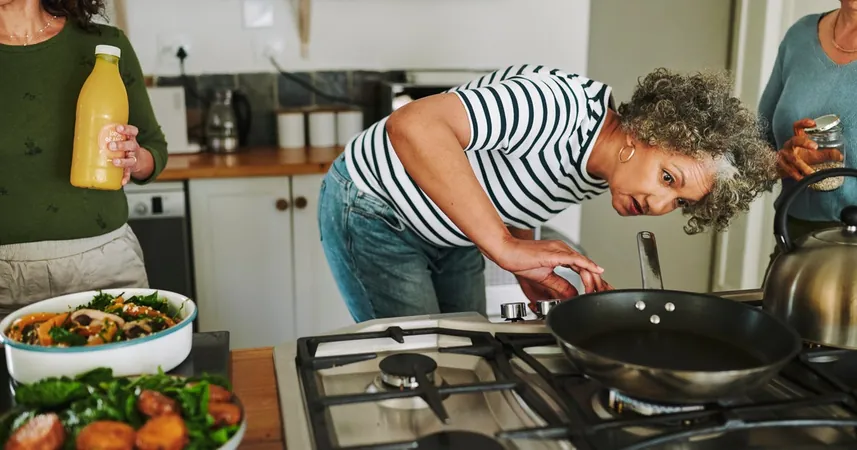
Is Your Gas Stove Dangerous? What Experts Say You Need to Know!
2025-05-04
Author: Ying
For almost a century, the phrase "Now you’re cooking with gas" has been synonymous with quality and efficiency in cooking. Many chefs, both amateur and professional, love gas stoves for their quick heat control and lower operating costs. No wonder around 75% of restaurants prefer natural gas for cooking, as found in a recent National Restaurant Association survey.
The Dark Side of Gas Cooking
However, there's a growing concern about the safety of cooking with gas. Natural gas contains harmful pollutants, and burning it generates even more toxic substances, sparking debates over potential bans on gas stoves in certain areas, particularly New York City and California. According to Darby Jack, a professor at Columbia University, the push for regulations is largely fueled by climate change concerns, with natural gas combustion being a substantial source of greenhouse gas emissions.
Toxic Fumes in Your Kitchen?
Though research is ongoing, experts agree that burning gas indoors releases a concerning amount of unhealthy chemicals. A recent study conducted by PSE Healthy Energy revealed that nearly all samples of natural gas from various homes contained benzene, a known carcinogen. The World Health Organization warns that there are no safe levels of benzene exposure, and the effects accumulate over time. Alarmingly, cities like Los Angeles and Denver reported benzene concentrations that were double those of other locations. Moreover, when gas ignites, it releases nitrous dioxide (NO2), which has been linked to respiratory issues like asthma, especially in children. These toxins can linger in the air for hours, often spreading to other rooms in the home.
Invisible Threats: Gas Leaks and Carbon Monoxide
The dangers of natural gas don't stop there. Gas leaks can lead to life-threatening explosions or carbon monoxide (CO) poisoning. The Environmental Protection Agency highlights that while natural gas itself doesn't contain CO, its incomplete combustion can produce this deadly gas. The CDC estimates that CO poisoning is responsible for nearly 400 deaths and over 100,000 emergency visits annually.
Evaluating Your Exposure Risk
If you're concerned about toxic chemicals in your home, home monitoring devices exist but are often impractical for consumers. For instance, while carbon monoxide detectors are essential, tracking methane, benzene, and NO2 isn't straightforward. Jack advises that the best strategy is to minimize toxin production when possible.
Boosting Indoor Air Quality While Cooking
Fortunately, enhancing indoor air quality doesn't necessarily require major renovations. One effective solution is to install a powerful exhaust hood that vents outdoors, rather than recirculating air. Research indicates that only about a third of home cooks regularly use their range hoods. Experts recommend turning it on anytime you cook, whether boiling water or preheating the oven, and keeping it on for 10-20 minutes afterward to ensure any lingering toxins are cleared.
Should You Make the Switch to Electric?
Both natural gas and propane stoves have similar emissions issues, and as Eric Lebel notes, newer gas stove technology may even exacerbate NO2 production. Concerns remain about the potential risks of switching to electric cooking. Although some believe electric options can lessen NO2 exposure, there isn't definitive evidence that this switch drastically improves health outcomes.
The Bottom Line on Gas Stove Safety
So, how much risk do gas stoves pose to you and your family? It largely depends on factors like age, exposure, and existing health conditions. For those who work in environments with gas cooking all day, the risk is elevated. Jack suggests that while healthy adults might have little to worry about, households with young children or individuals with respiratory issues may need to consider their gas stove's impacts more seriously.
In summary, while gas cooking offers undeniable advantages, it's essential to stay informed about the potential risks and take necessary precautions to ensure your family's safety.


 Brasil (PT)
Brasil (PT)
 Canada (EN)
Canada (EN)
 Chile (ES)
Chile (ES)
 Česko (CS)
Česko (CS)
 대한민국 (KO)
대한민국 (KO)
 España (ES)
España (ES)
 France (FR)
France (FR)
 Hong Kong (EN)
Hong Kong (EN)
 Italia (IT)
Italia (IT)
 日本 (JA)
日本 (JA)
 Magyarország (HU)
Magyarország (HU)
 Norge (NO)
Norge (NO)
 Polska (PL)
Polska (PL)
 Schweiz (DE)
Schweiz (DE)
 Singapore (EN)
Singapore (EN)
 Sverige (SV)
Sverige (SV)
 Suomi (FI)
Suomi (FI)
 Türkiye (TR)
Türkiye (TR)
 الإمارات العربية المتحدة (AR)
الإمارات العربية المتحدة (AR)